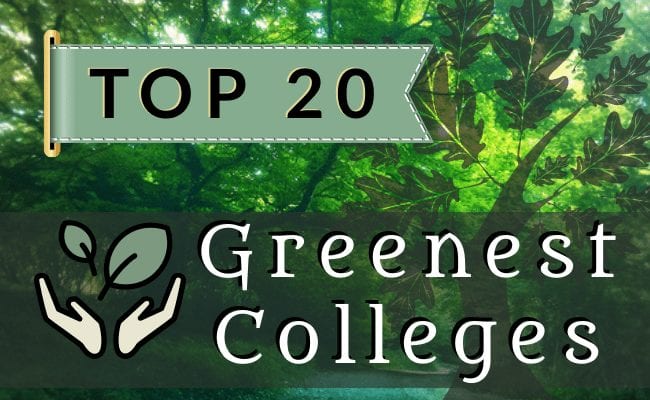Top 20 Greenest Colleges

Find your degree
With the dangers of global warming, loss of non-renewable resources and the economic and worldwide impact of wasted resources, many schools are working towards becoming more eco-friendly and more students are morally committed to attending the greenest colleges than ever before. Because of this, we have ranked schools based on how green they currently are and how green they are striving to be.
Methodology

We have ranked each school based on the following criteria:
- 50% Current Green Measures: Each school is ranked on a scale of 1 to 20 based on the current green measures, programs, and education that the school currently has.
- 50% Future Green Commitments: Each school is ranked on a scale of 1 to 20 based on the future commitments that the school has made to be more eco-friendly.
Ties were broken with the following criterion:
- Alphabetical Order
With the best possible score of 40, each school has received a score based on the combination of the above criteria. All of the information utilized for the rankings was obtained from each respective school’s website and the Association for the Advancement of Sustainability in Higher Education (AASHE)‘s website.
AASHE is a not-for-profit and unbiased third-party organization that rates schools based on how eco-friendly they operate. All of the schools in this ranking have received a Gold rating from AASHE’s STARS program with the exception of Colorado State University, which received a Platinum rating and is currently the only school with such a designation.

Poultney, VermontGreen Mountain College’s Green Rating: 27/40Originally established in the year of 1834, Green Mountain College, which is a private liberal arts college located in Poultney, Vermont, has set a 100% renewable source energy program for the year of 2020.
Green Mountain College also features a biomass facility (which generates approximately 85% of the heat which is used on the entire campus), a solar array and a windmill which helps to supplement the school’s energy needs, reducing their need for non-renewable resource energy sources. In addition to this, the school was able to reach climate neutrality and is the first school in the nation to be named an EPA Energy Star campus, earning a Gold Rating from the Association for the Advancement of Sustainability in Higher Education in their STARS program, and is one of only 252 schools.

Santa Clara, CaliforniaSanta Clara University’s Green Rating: 28/40Located in Santa Clara, California, Santa Clara University is a private, not-for-profit and Jesuit-affiliated research university.
Santa Clara has many green initiatives in effect, and many more green initiatives planned for the future. Some of the eco-friendly acts the school is currently performing include things such as conserving water, utilizing recycled water in the grounds water features, providing students with source-sound food, reducing waste and saving energy.
The school also encourages attending students to do their part as well and provides them with various pieces of literature on how they can decrease their footprint while attending and after graduation. Santa Clara has a Gold rating in the Association for the Advancement of Sustainability in Higher Education’s STARS program.

Chapel Hill, North CarolinaUniversity of North Carolina – Chapel Hill’s Green Rating: 28/40
School Profile
Located in Chapel Hill, North Carolina, the University of North Carolina (which is commonly referred to as UNC) is a public research university and is one of the oldest schools in the United States.
UNC has received many accolades for its current green initiatives–such as having received a Gold rating in Association for the Advancement of Sustainability in Higher Education’s STARS program. The University of North Carolina – Chapel Hill has also launched a green initiative in early 2016 to strive towards having zero waste, zero water waste, and zero carbon emissions on campus. The program is called the Three Zeros Initiative, and they hope to obtain their set goals as soon as possible.
UNC is continually working towards reducing its carbon footprint and encourages all faculty and attending students to do their part. To effectively facilitate this, the school provides numerous reading materials that outline what can be done to help.

Greenville, South CarolinaFurman University’s Green Rating: 29/40Located in Greenville, South Carolina, Furman University is a private, not-for-profit and Protestant-affiliated research university.
Furman University is the only liberal arts school located in the nation that offers a bachelor’s degree in Sustainability Sciences. Furman is also committed to providing a green learning environment through the utilization of various green initiatives, such as conserving water, reducing waste and reducing its overall carbon footprint.
Furman encourages both the school’s faculty and the school’s students to each do their part in reducing waste. In addition to this, the school is planning to build a $1.7 million dollar solar facility, which will be utilized to provide the school with much–if not all–of its future power needs. Furman has also received a Gold STARS rating from the Advancement of Sustainability in Higher Education.

Corvallis, OregonOregon State University’s Green Rating: 30/40
School Profile
Oregon State University, which is located in Corvallis, Oregon, is a public land-grant, sea-grant, space-grant and sun-grant research university.
Originally established in the year of 1868, Oregon State University–which is commonly referred to as OSU–has many green initiatives and practices in effect. These include continually striving towards reducing the size of their carbon footprint, providing faculty, students, and visitors with electric vehicle recharging stations, and providing ride-sharing programs and utilizing solar arrays for much of the school’s energy needs.
Oregon State University, for its tireless eco-centric efforts, has been awarded a Gold rating in the STARS program and is nationally recognized for its green efforts. The school has been able to achieve this through the efforts of the OSU’s students and staff, who are encouraged to pitch in and help in whatever way they can.

Portland, OregonPortland State University’s Green Rating: 30/40
School Profile
Originally established in the year of 1946 and located in Portland, Oregon, Portland State University is a public research university that has obtained a Gold rating in AASHE’s STARS program.
Portland State University–which is commonly referred to as PSU–currently has 8 LEED-certified buildings located on the campus and 9 LEED-certified buildings in total. PSU also purchases 37% of all of the school’s food needs from local-sourced, sustainable farms and food providers.
In addition to this, the school is consistently working towards reducing the amount of waste that is produced by the school, the faculty and by the students. They achieve this through various initiatives such as all pre-consumer food waste collected for composting in PSU’s kitchens, recycling all cooking oil into biofuels, encouraging students and faculty to be conscientious with their energy usage and utilizing solar photovoltaic (PV) arrays for a portion of the school’s energy needs.

Santa Barbara, CaliforniaUniversity of California – Santa Barbara’s Green Rating: 30/40Located in Santa Barbara, California and originally established in the year of 1891 as the Anna Blake School, the University of California – Santa Barbara is a public space-grant research university and is commonly referred to as UCSB.
The University of California – Santa Barbara has reduced its total electricity consumption by 39% over the past ten years, natural gas usage was down by 16% in 2015 in comparison to the natural gas usage in 2014 and obtained a Gold rating in Stars in the 2013/2014 school year.
In addition to the numerous green initiatives that are currently in place at the University of California – Santa Barbara, the school has plans to become a carbon-neutral school by the year 2025, while continually decreasing the amount of material and water waste that the school generates yearly. The school encourages both faculty and students to get involved in whatever capacity that they are able, from doing their part in lowering energy usage to helping pick up and recycle waste.

Amherst, MassachusettsUniversity of Massachusetts – Amherst’s Green Rating: 30/40Originally established in 1863 and located in Amherst, Massachusetts, the University of Massachusetts – Amherst is a public land-grant research university.
School Profile
The University of Massachusetts – Amherst prides itself in the green contributions it makes, offering students programs such as Bike Sharing, Green Events, and the Minute Riders Program–a student-led, tandem-bike-powered compost pickup service.
In addition to this, the school makes an effort to reduce its waste and carbon footprint continually and has obtained a Gold rating in the STARS system. UMass–which the school is commonly referred to–also has a requirement that it will purchase a minimum of 20% of all the school’s food need from locally grown and sound, renewable farms and other local and sound-sources.

Atlanta, Georgia
Emory University’s Green Rating: 31/40Located in the Druid Hills area of Atlanta, Georgia and established in the year of 1836, Emory University is a private, not-for-profit, Methodist-affiliated research university.
Emory University has obtained a Gold rating in the STARS program and has many green initiatives in effect, such as purchasing local, sound-source and sustainable foods, conserving water, saving energy, providing recycle refuse bins, raising energy use awareness, offering commute alternatives and ride-share programs.
The school also has one of the largest collection of LEED-certified building spaces by square-footage among all postsecondary educational campuses located within America. In addition to these efforts, Emory also runs a Forest Management Plan and a Pollinator Protection Plan and educates the school’s faculty, students and the members of the surrounding communities on what they can do to help and why these plans are so vital.

Boulder, ColoradoUniversity of Colorado – Boulder’s Green Rating: 32/40Located in Boulder, Colorado and originally established in the year of 1876, the University of Colorado – Boulder (which is commonly referred to simply as CU) is a public space-grant research university that has obtained a Gold rating in the STARS program.
The University of Colorado – Boulder does its part in making the world a greener, healthier place by operating 18 LEED-certified buildings (which are 25% to 40% more efficient than traditional buildings) on campus, working towards reducing the school’s carbon footprint and wastes and by educating the school’s students and residents of the surrounding communities on how they can make greener choices in their lives.
The school is also working towards increasing the campus’ diversion rate of municipal solid waste (MSW) to 90% by 2020 and reducing the school’s greenhouse gas emissions by 20% by the year of 2020.

Storrs, ConnecticutUniversity of Connecticut’s Green Rating: 32/40Originally established in the year of 1881 and located in Storrs, Connecticut, the University of Connecticut is a public land-grant research university that has obtained a Gold rating in the STARS program.
The University of Connecticut (which is commonly referred to as UConn) has made great strides in going green by reducing waste generation, conserving water and lower energy usage on the campus. The school has achieved this by educating and encouraging the school’s staff and attending students to be more conscientious about the impact that they make on the environment.
The school also has plans to reduce further the amount of waste it generates, the energy that is used, and the resources that are used across the campus. The school also offers alternative transportation opportunities and holds lectures on the impact that humans have on the environment around them and the global environment as a whole.

Oshkosh, WisconsinUniversity of Wisconsin – Oshkosh’s Green Rating: 32/40Located in Oshkosh, Wisconsin and originally established in the year of 1871, the University of Wisconsin – Oshkosh (which is commonly referred to as UW Oshkosh) is a public research university and has obtained a Gold rating in the STARS program.
UW Oshkosh provides its faculty and students with over 6,000 eco-centric resources online and encourages them to be ecologically conscientious in their day-to-day life. The school practices a persistent effort in reducing the school’s energy usage and waste generation in an attempt to lower its overall footprint on the environment. They achieve this with recycling programs, water conservation programs, offering ride-share programs, educating about the importance of being eco-friendly and with waste reduction programs.
In addition to this, in 2016, the University of Wisconsin – Oshkosh was named a Certified Wildlife Habitat for its efforts in protecting the local wildlife.

Tampa, FloridaUniversity of South Florida’s Green Rating: 33/40Originally established in the year of 1956 and located in Tampa, Florida, the University of South Florida is a public space-grant research university which has received a Gold rating in the STARS program.
The University of South Florida–which is commonly referred to simply as USF–is home to the Patel College of Global Sustainability, a degree-granting college whose mission is to encourage sustainable urban development practices and to help society live harmoniously with the natural world around us.
The college offers a Master of Arts degree in Global Sustainability is currently available in 9 concentrations–Building Sustainable Enterprises, Climate Change and Sustainability, Coastal Sustainability, Entrepreneurship, Water, Food Sustainability and Security, Renewable Energy, Sustainable Tourism and Sustainable Transportation–and helps to teach students the impact we have on our environment. In addition to this, the school also continually works towards reducing its waste production, energy usage, and carbon footprint.

Waterville, MaineColby College’s Green Rating: 35/40Located in Waterville, Maine and originally established in the year of 1813 as the Maine Literary and Theological Institution, Colby College is a private, not-for-profit liberal arts college that has obtained a Gold rating in the STARS program.
Colby College holds the distinction of becoming the fourth postsecondary educational institute in the nation to achieve carbon neutrality–a feat that was reached in the year of 2003. Colby College also offers a nationally-recognized Environmental Studies program in which students may enroll.
Also, the school is continually making an effort to raise ecological awareness in its staff, its attending students and the residents of the surrounding communities. The school maintains many LEED-certified buildings, sources locally grown and sustainable foods and is firmly committed to recycling as much as possible.

Stanford, CaliforniaStanford University’s Green Rating: 35/40Located in Stanford, California, Stanford University–a private, not-for-profit research university–was originally established in the year of 1891 by Leland Stanford and has obtained a Gold rating in the STARS program.
The school’s efforts in conserving energy include the following benchmarks (with the year 2000 as a baseline): energy usage is down by 8%, domestic water usage is down by 26%, and landfill waste is down by 27%.
In addition to this, Stanford University has saved 15% of its water and reduced GHG production (greenhouse gasses) by 68%. The school is continually making an effort to reduce its impact on the environment further and encourages its faculty and students to do their part and educates them to be more conscientious of the effects that they can have on the natural world, both good and bad.
Stanford also maintains a sustainable and organic farm on campus, which helps to produce much of the school’s food needs.

Washington, D.C.American University’s Green Rating: 36/40Located in Washington, D.C., and originally established in the year of 1893, American University is a private, not-for-profit and Methodist-affiliated research university which has obtained a Gold Rating in the STARS program.
American University is committed to becoming a neutral climate school by the year 2020 and is making great strides towards this goal each year. The school encourages faculty and staff to help reduce waste and is striving for zero waste sent to landfills and incinerators. They hope to do this by educating how and why individuals can and should help.
AU also promotes alternative transportation options, such as ride-sharing programs and taking public transit as opposed to personal vehicles. American University conserves water and energy and is a major proponent of recycling and resource conservation efforts. The school also offers academic programs in Environmental Film Making, Sustainability Management, Global Environmental Politics and Environmental Science.

Phoenix, Arizona
Located in Phoenix, Arizona, Arizona State University is a public research university which was originally established in the year of 1885 and which has obtained a Gold rating in the STARS program.
The school maintains a solar array, wind turbines and the Julie Ann Wrigley Global Institute of Sustainability, where students can choose to obtain a degree in Sustainable Energy, Materials, and Technology, The Economics of Sustainability, Ecosystems Sustainability, Society and Sustainability, Policy and Governance in Sustainable Systems, International Development and Sustainability and Sustainable Urban Dynamics among others.
The school is also committed to decreasing its carbon footprint, its waste production, and energy usage; with much of the school’s energy being provided by the aforementioned solar arrays and wind turbines. The school encourages its faculty and students to do what they can to help the schools achieve its green goals and to help make a positive impact on the environment, both locally and globally, by being conscientious of how they live with nature.

Athens, GeorgiaUniversity of Georgia’s Green Rating: 36/40The University of Georgia, which is commonly referred to as UGA, is a public land-grant, sun-grant and sea-grant research university located in Athens, Georgia and which was originally established in the year of 1785.
UGA has obtained a Gold rating in the STARS program and provides students with numerous Sustainability Grants yearly. UGA composts organic waste, conserves water, strives to reduce its waste production and energy consumption and encourages students and faculty to be committed to being ecologically conscientious.
The University of Georgia promotes alternative transportation, most notably using a bicycle to get around the campus and town. The school provides experiential learning experiences in ecologically-centric areas through Sustainability Internships, Study Abroad Programs and the school’s “Living Laboratory” program–which features numerous green spaces and works towards protected the area’s natural resources.

Irvine, CaliforniaUniversity of California – Irvine’s Green Rating: 38/40Located in Irvine, California, the University of California – Irvine is a “Public Ivy” land-grant research university which was originally established in the year of 1965 and which has obtained a Gold rating in the STARS program.
The University of California – Irvine–which is commonly referred to as UC Irvine or simply as UCI–is committed to reducing its negative ecological impacts and increasing its positive environmental impacts. The school is striving to achieve this through educating faculty and students on what they can do to help, and why they should provide their aid, and by encouraging individuals to make conscientious ecological choices regarding sustainability and waste production.
The school makes an effort to conserve water, save energy and to decrease the amount of waste it sends to landfills and incinerators. The school also obtains much of its food from locally grown, sustainable and sound-source food providers and farms.

Fort Collins, ColoradoColorado State University’s Green Rating: 39/40Located in Fort Collins, Colorado, Colorado State University was originally established in the year of 1870 and is a public land-grant research university.
Colorado State University (which is commonly referred to as CSU) hold the distinction of being the only school to have a Platinum rating in the STARS program, a fact which contributed to it being chosen as the top pick eco-friendly school of 2016.
CSU maintains a sustainable and organic farm, which provides the school with much of its food needs and offers academic courses in the following areas: Climate Change and Energy, Food Security, Environmental Institutions and Governance, Sustainable Communities, Land and Water Resources and Biodiversity, Conservation, and Management.
In addition to this, the school strives towards being ecologically friendly in many other ways. 92% of the school’s dining area waste is diverted from landfills; the school maintains 22 LEED-certified buildings and the school has 13 solar arrays, which it utilizes for much of its energy needs.
School Profile
Related Rankings:
- Top 100 Online Colleges
- Oldest Colleges with Online Degree Programs
- Top Most Affordable Private Schools
- The Best Online Colleges for Students with Autism
- Top Online Colleges with the Best Career Services
- The Most Ethnically Diverse Online Colleges
- The 30 Most Political Universities
- 60 Blue-Ribbon College Farms
